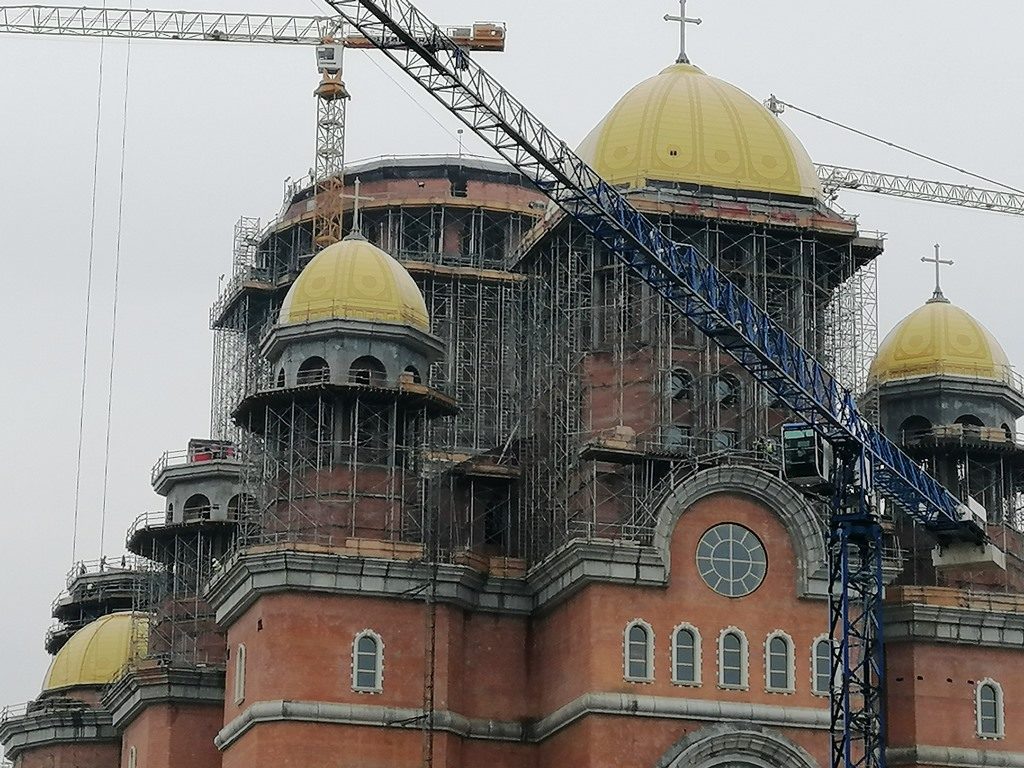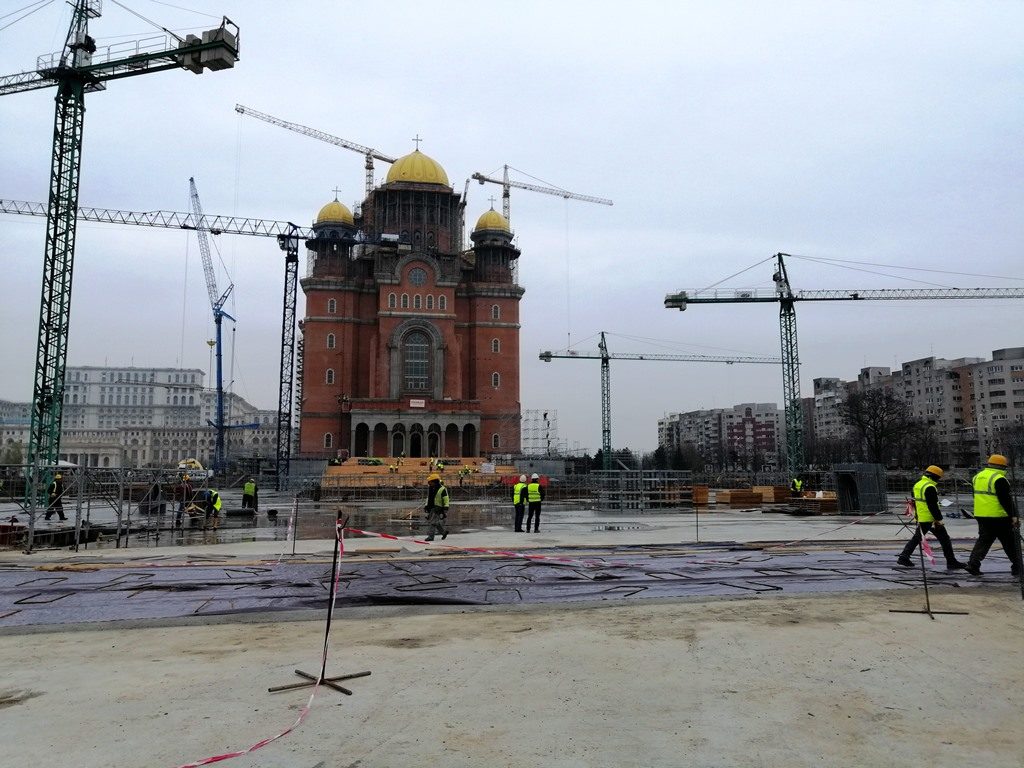:quality(80)/business-review.eu/wp-content/uploads/2018/11/Cathedral-of-the-Nations-Salvation.jpg)
The pharaonic ambition of Romania’s head of the Orthodox Church – Patriarch Daniel – is about to become a reality as it is scheduled to open in less than two days, five days before Romania turns 100 years old. Eight years after construction began and over EUR 110 million later, the second largest church in Europe and the biggest orthodox church in the world is ready to welcome the Romanian people. A BR reporter went to visit the site today, where around 700 workers, nuns and bodyguards have done everything the Patriarch has asked for as if the orders came God himself.
There are some Romanians who believe that the People’s Salvation Cathedral is the most important project in the country. It may become a spiritual shelter for many believers, and it’s probably welcomed by most members of the church. What’s certain is that it’s a good way for state officials to claim their hypocritical faith and display themselves in front of the masses, as the Romanian Orthodox Church expects 50,000 people outside the cathedral at its consecration on Sunday, November 25, as well as 2,000 public figures and politicians inside.
But the Cathedral itself remains a perfectly useless building, up on Arsenal Hill, near the Palace of the Parliament. It has already cost EUR 110 million, mostly in public funds allocated by the government or the Bucharest municipality.
Now, almost eight years later, the cathedral is more than 95 percent ready and its consecration is scheduled for Sunday, 25 November. The final works are being done by around 700 people.
- Length = 126,1 m
- Width (in abs.) = 67.7 m
- Height = 120 m as a block of 30 floors
- Total built area = 13,668.5 sqm
- Total developed area = 52,529.2 sqm
- Total useful area = 36,897.96 sqm (ground floor + three additional floors)
- The main space at +0.00 (pronaos and naos) allows seating for 1,000 people.
The cathedral’s structure consists of two main components: the first is the visible side of the cathedral, which includes the upper levels located above the ground; the second part is the unseen side, which includes three underground levels. The above-ground structure is 126.1 meters long, 67.7 meters wide and 120 meters high up to the base of the main tower cross.
This is where the main liturgical spaces can be found, arranged in succession, according to the Orthodox liturgical requirements: the main access on the west side through a porch with arches, then the exonartex, the narthex, the nave and the altar, located on the eastern end of the church. On the north and south sides of the nave are two lateral apses, and over the nave is the main tower (the Pantocrator).
The cathedral has six bells weighing a total of 33 tons, mounted in the “Bell Tower” on the western façade, at a height of 60 meters.
The bells were built in the Grassmayr factory in Innsbruck, Austria, have a 15-year warranty and an estimaded life of 400 years. They were brought to the country in May 2017.
“We’ve been working for a year and we are almost ready, here on the outside. Underground there’s a one-level parking lot, but the cathedral has three floors underground. Take a photo of me so that my boss can see that I’m working,” one of the workers tells me as he is covering a fence with some canvas.
“We would work on anything, it doesn’t matter. I don’t care that it’s a cathedral. It could have been an apartment building or a mall. I’ve worked at a 60-meter height, and I am proud,” says another.
Unfortunately, access inside the cathedral is forbidden until Sunday, and there is mud everywhere, so the guards’ vigilant eyes stop me from getting any closer – I stayed quite close to the main gate.
I saw Vasile Banescu, the patriarchate’s spokesman, and asked him whether he could get me inside the cathedral.
“You can’t go in until Sunday, after the ceremony. You have to follow the rules. And pay attention on Sunday, the SPP (Protection and Security Service) will impose rules”, he says. But I won’t be there on Sunday…

Later, in 1920, King Ferdinand sent a letter to Metropolitan bishop Miron Cristea, supporting the project, but to no end.
In 1925, when the Romanian Orthodox Church became an independent patriarchate, Cristea suggested Carol Park as a site for the cathedral, but his idea was defeated in favour of Bibescu Voda Square. Then, in 1929, the first steps were taken to start works on the cathedral, but the lack of funds led to the construction being postponed and eventually forgotten.
The concept sunk into oblivion for the following 66 years, until 1995, when the Romanian Orthodox Church celebrated the 70th anniversary of its independence, and Patriarch Teoctist proposed a new large cathedral, on a scale similar to the newly rebuilt Cathedral of Christ the Saviour in Moscow. But it turned out even larger. In fact, it is currently the largest orthodox church in the world, with its 6,000 sqm footprint. Saint Isaac’s Cathedral in Sankt Petersburg would have been larger, at 7,000 sqm, but it was turned into a museum in 1931.

Later on, in October 2004, the senate voted to pass the project, estimated to take 6 years. Three years later, in November 2007, Patriarch Daniel of Romania laid the foundation stone, gave his blessing and consecrated the site at Arsenal Hill.
In construction since 2010
In December 2010, the cathedral’s construction began. It would take 100,000 cubic meters of concrete, 45,000 tons of rigid armature and about 25,000 tons of flexible armature to complete the project – ten times more than a ten-storey apartment building.
The cathedral is designed with seating for approximately 6,000 worshipers (and 125,000 in the inner courtyard), a greater than tenfold increase on the current patriarchal cathedral.

Consecration schedule
The Patriarchate announced the program of events related to the consecration of the National Cathedral. Thus, on Friday at 12.45, Patriarch Daniel will welcome Ecumenical Patriarch Bartholomew I of Constantinople, accompanied by a delegation of the Ecumenical Patriarchate, as well as a delegation from the Orthodox Church of Greece, led by Metropolitan of Patra, Chrysostom.

The Greek Orthodox Church delegation will bring the reliquary with the hand of St. Apostle Andrew, the protector of Romania. The cane will remain in the Patriarchal Cathedral on the Mitropoliei Hill until Saturday at 4 pm.
At 4.30 pm, the reliquary with the hand of Saint Apostle Andrew and the reliquary with a fragment of the relics of the Holy Great Martyr Ecaterina will be worshiped on the porch of the People’s Salvation Cathedral, where they will remain until Sunday at 1 pm.
This moment will be followed by a memorial service for fallen Romanian heroes, officiated in the National Cathedral by Patriarch Daniel along with other hierarchs. Starting at 6 pm, a watch service dedicated to the Great Martyr Ecaterina and the Holy Martyr Mercurie will be hosted in the Chapel of the Salvation Cathedral.
On Sunday, from 8 am, the People’s Salvation Cathedral will be attended by the work of the Acatist of the Great Martyr Ecaterina, followed at 9.00 by the altar sanctification service. At the end of the service, the Sanction Act will be read.
The Divine Liturgy will begin at 10.30 am and will take place inside the National Cathedral. At 1 pm, the reliquary with the hand of St. Apostle Andrew and the the one with the relics of the Great Martyr Ecaterina will be placed at the exit of the altar.
Believers will be able to follow the consecration service on screens from the esplanade in front of the cathedral.
Impressive or pharaonic?
The center-right french newspaper Le Figaro named the cathedral “a pharaonic project” and “worthy of Nicolae Ceausescu’s megalomania”.
The truth is that as I’m swimming through the mud, I can’t stop asking myself, what is the point? Why did this country have to support 75 percent of the costs for the construction of this giant?

While huge, the building is just a big church, so I’m not impressed. I am rather impressed, however, by the volume of materials and work that went into it. Then a thought pops into my mind: this cathedral won’t save anybody, even as it’s finished now, in the Centennial year. It is not meant to save anyone; it is just a symbol of power on one side and discontent on the other, and, like many other subjects, it tends to divide Romanians instead of bring them together.



:quality(80)/business-review.eu/wp-content/uploads/2024/04/1_Transport.jpg)




:quality(80)/business-review.eu/wp-content/uploads/2024/02/IMG_6951.jpg)

:quality(80)/business-review.eu/wp-content/uploads/2024/04/COVER-1.jpg)



:quality(80)/business-review.eu/wp-content/uploads/2024/04/cover-april.jpg)
:quality(50)/business-review.eu/wp-content/uploads/2024/04/0x0-Supercharger_18-scaled.jpg)
:quality(50)/business-review.eu/wp-content/uploads/2024/04/Schneider-Electric-anunta-castigatorii-Sustainability-Impact-Awards-2023-in-Romania-scaled.jpg)
:quality(50)/business-review.eu/wp-content/uploads/2024/04/Premier-Energy-Group-1.jpg)